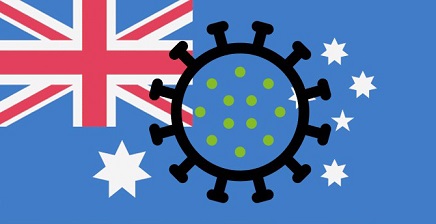COVID-19 News: After COVID-19 Peak In Late 2023, Many States In Australia Reporting A New Wave Driven By JN.1 In 2024!
Nikhil Prasad Fact checked by:Thailand Medical News Team Jan 09, 2024 1 year, 3 months, 1 week, 2 days, 43 minutes ago
COVID-19 News: Australia, having weathered the storms of the COVID-19 pandemic in late 2023, now finds itself grappling with an intensified crisis as the JN.1 subvariant of the Omicron strain sparks a relentless surge in cases. This resurgence, characterized by a unique "wave-on-wave" pattern, poses a multifaceted challenge for health authorities nationwide.
https://covidlive.com.au/
 New 2024 COVID-19 Wave In Australia Driven By JN.1
The JN.1 Onslaught
New 2024 COVID-19 Wave In Australia Driven By JN.1
The JN.1 Onslaught
The JN.1 subvariant, designated a "variant of interest" by the World Health Organisation due to its alarming global spread, has swiftly become the dominant strain in Victoria. Health authorities, particularly Dr Clare Looker, Victoria's chief health officer, have expressed concern about the unusual timing of the JN.1 wave, coinciding with the state's emergence from the earlier Omicron wave. This has created a continuous surge, a phenomenon described as a "wave-on-wave" pattern.Local
COVID-19 News outlets are also reporting that hospitals across Australia are once again witnessing a rise in COVID-19 admissions and long queues at outpatient clinics and beginning to once again feel the stress.
Impact Across States
According to the latest COVID-19 surveillance report from Victoria's Department of Health, an average of 377 people were hospitalized with the virus, an increase since the early December peak of 326 cases in hospital.
https://www.health.vic.gov.au/infectious-diseases/victorian-covid-19-surveillance-report
The impact of the JN.1 subvariant is not confined to Victoria; it has made inroads into New South Wales (NSW) as well. Although official 2024 surveillance data from NSW Health is pending, the last week of 2023 has already indicated a high level of COVID-19 activity.
https://www.health.nsw.gov.au/Infectious/covid-19/Pages/reports.aspx
Western Australia, too, is witnessing a resurgence, with COVID-19 hospitalizations reaching their highest since winter and ten deaths recorded in the week before Christmas.
Experts, including Associate Professor Stuart Turville, predict that 2024 will be dominated by JN.1 and its sub-lineages, potentially eclipsing the patterns observed with previous subvariants.
Understanding JN.1
The factors driving the rapid ascendancy of JN.1 remain under investigation. Evidence from the United Kingdom, where the subvariant has spread widely, suggests that it does not cause more severe disease. Despite its accelerated spread, JN.1 has not been accorded its own Greek alphabet name, akin to Omicron or Delta. The surge is expected to reach its pea
k in the coming weeks, with cautious optimism that hospitalizations may not witness a dramatic surge.
Public Health Measures
Health authorities stress the pivotal role of public health measures in curtailing the spread of JN.1. The introduction of a new monovalent vaccine in Australia, reportedly effective against the subvariant, has prompted recommendations for booster shots, especially for individuals over 75 and those vulnerable who have not received a vaccine in the last six months. Dr. Looker underscores the importance of preventing disease spread to safeguard vulnerable populations in the face of elevated COVID-19 activity.
Navigating a Double Wave
Victoria, already reeling from the initial impact of the Omicron wave, now finds itself in the midst of a double COVID-19 wave fueled by the JN.1 variant. Contrary to the expected lull or return to baseline between waves, the state experiences a continuous "wave-on-wave" pattern. The January report from Victoria's Department of Health highlights the exponential growth of JN.1 cases, firmly establishing it as the most prevalent subvariant in the region. According to the report, the latest quantitative wastewater measures also indicate high COVID-19 viral loads in Victorian wastewater. Metropolitan wastewater catchments have shown increased levels, while regional quantitative wastewater levels remain high.
Despite an increase in COVID-19 hospitalizations, deaths in Victoria have declined since in the 28 days to December 19, compared to the prior 28-day period.
A total of 168 deaths were attributed to the virus between November 22 and December 19, although the report noted a two-week lag in the reporting period.
Challenges and Recommendations
Despite the surge in COVID-19 hospitalizations, there is a glimmer of hope as the death rate in Victoria has declined in the 28 days to December 19 compared to the preceding period. Health authorities emphasize the need for high-risk populations, including senior Australians and those with underlying medical conditions, to adopt protective measures such as mask-wearing and surveillance testing.
Conclusion
As Australia confronts the dual waves of COVID-19 driven by the relentless JN.1 subvariant, the situation underscores the imperative of continued vigilance, robust public health measures, and a proactive approach to vaccination and booster shots. The evolving nature of the pandemic necessitates flexibility in response strategies and a concerted effort to protect vulnerable populations, thereby mitigating the impact of this new wave. Australians are urged to remain resilient, adhere to health guidelines, and collectively contribute to curbing the spread of the virus as the nation navigates through this challenging phase of the ongoing pandemic.
For the latest
COVID-19 News, keep on logging to Thailand Medical News.
